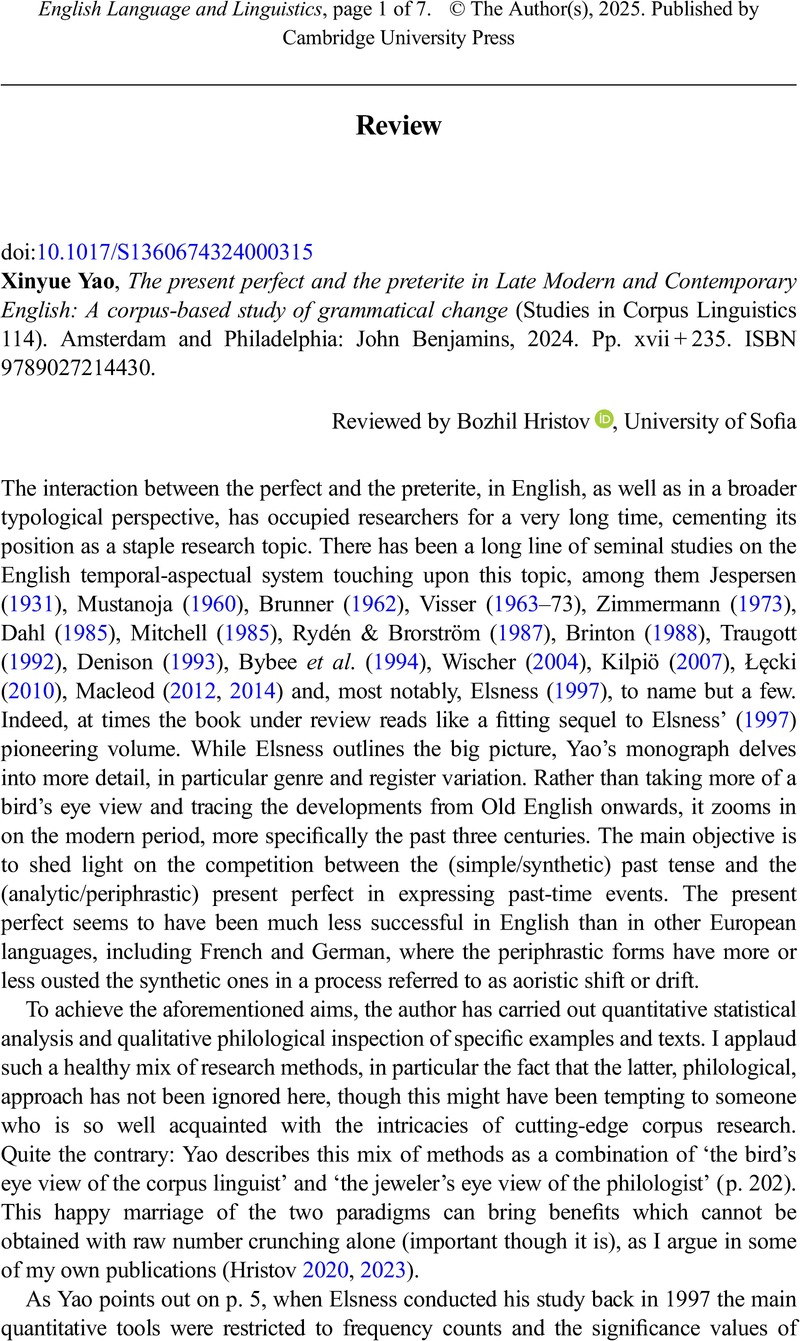No CrossRef data available.
Article contents
Xinyue Yao, The present perfect and the preterite in Late Modern and Contemporary English: A corpus-based study of grammatical change (Studies in Corpus Linguistics 114). Amsterdam and Philadelphia: John Benjamins, 2024. Pp. xvii + 235. ISBN 9789027214430.
Review products
Xinyue Yao, The present perfect and the preterite in Late Modern and Contemporary English: A corpus-based study of grammatical change (Studies in Corpus Linguistics 114). Amsterdam and Philadelphia: John Benjamins, 2024. Pp. xvii + 235. ISBN 9789027214430.
Published online by Cambridge University Press: 11 February 2025
Abstract
An abstract is not available for this content so a preview has been provided. Please use the Get access link above for information on how to access this content.

- Type
- Book Review
- Information
- Copyright
- Copyright © The Author(s), 2025. Published by Cambridge University Press
References
Brinton, Laurel J. 1988. The development of English aspectual systems: Aspectualizers and post-verbal particles. Cambridge: Cambridge University Press.Google Scholar
Brunner, Karl. 1962. Die englische Sprache: Ihre geschichtliche Entwicklung 2 [The English language: Its historical development]. Tübingen: Niemeyer.Google Scholar
Bybee, Joan L., Perkins, Revere D. & Pagliuca, William. 1994. The evolution of grammar: Tense, aspect and modality in the languages of the world. Chicago: University of Chicago Press.Google Scholar
Denison, David. 1993. English historical syntax: Verbal constructions. London and New York: Longman.Google Scholar
Drinka, Bridget. 2017. Language contact in Europe: The periphrastic perfect through history. Cambridge: Cambridge University Press.Google Scholar
Elsness, Johan. 1997. The perfect and the preterite in contemporary and earlier English. Berlin: Mouton de Gruyter.CrossRefGoogle Scholar
Fløgstad, Guro Nore. 2016. Preterit expansion and perfect demise in Porteño Spanish and beyond: A critical perspective on cognitive grammaticalization theory. Leiden and Boston: Brill.CrossRefGoogle Scholar
Hristov, Bozhil. 2020. Grammaticalising the perfect and explanations of language change: Have- and be-perfects in the history and structure of English and Bulgarian. Leiden and Boston: Brill.CrossRefGoogle Scholar
Hristov, Bozhil. 2023. Agreement and the grammaticalisation of perfect and passive constructions in the Anglo-Saxon Chronicle. Journal of Historical Syntax 7(4), 1–51.Google Scholar
Jespersen, Otto. 1931. A Modern English grammar on historical principles, part IV: Syntax, vol. 3: Time and tense. London: Allen and Unwin.Google Scholar
Keller, Rudi. 1990. Sprachwandel: Von der unsichtbaren Hand in der Sprache [On language change: The invisible hand in language]. Tübingen: A. Francke Verlag.Google Scholar
Kilpiö, Matti. 2007. Auxiliation in progress: Diachronic grammaticalisation changes in Old English and Early Middle English HAVE perfects. In Rissanen, Matti, Hintikka, Marianna, Kahlas-Tarkka, Leena & McConchie, Rod (eds.), Change in meaning and the meaning of change: Studies in semantics and grammar from Old to Present-Day English, 323–43. Vaajakoski: Gummerus Kirjapaino Oy.Google Scholar
Łęcki, Andrzej M. 2010. Grammaticalisation paths of have in English. Frankfurt am Main: Peter Lang.CrossRefGoogle Scholar
Macleod, Morgan. 2012. The perfect in Old English and Old Saxon: The synchronic and diachronic correspondence of form and meaning. PhD thesis, University of Cambridge.Google Scholar
Macleod, Morgan. 2014. Synchronic variation in the Old English perfect. Transactions of the Philological Society 112(3), 319–43.CrossRefGoogle Scholar
Mitchell, Bruce. 1985. Old English syntax, 2 vols. Oxford: Oxford University Press.CrossRefGoogle Scholar
Mustanoja, Tauno F. 1960. A Middle English syntax, vol. I: Parts of speech. Helsinki: Société Néophilologique.Google Scholar
Rydén, Mats & Brorström, Sverker. 1987. The be/have variation with intransitives in English with special reference to the Late Modern period. Stockholm: Almqvist & Wiksell.Google Scholar
Traugott, Elizabeth Closs. 1992. Syntax. In Hogg, Richard M. (ed.), The Cambridge history of the English language, vol. I: The beginnings to 1066, 168–289. Cambridge: Cambridge University Press.CrossRefGoogle Scholar
Visser, Frederik Th. 1963–73. An historical syntax of the English language, 3 vols. Leiden: Brill.Google Scholar
Wischer, Ilse. 2004. The have-perfect in Old English. In Jay, Christian J., Horobin, Simon & Smith, Jeremy (eds.), New perspectives on English historical linguistics, 243–55. Amsterdam: John Benjamins.CrossRefGoogle Scholar
Zimmermann, Rüdiger. 1973. Structural change in the English auxiliary system: On the replacement of be by have. Folia Linguistica 6, 107–17.CrossRefGoogle Scholar



